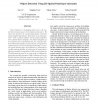Free Online Productivity Tools
i2Speak
i2Symbol
i2OCR
iTex2Img
iWeb2Print
iWeb2Shot
i2Type
iPdf2Split
iPdf2Merge
i2Bopomofo
i2Arabic
i2Style
i2Image
i2PDF
iLatex2Rtf
Sci2ools
CVPR
2005
IEEE
2005
IEEE
Object Detection Using 2D Spatial Ordering Constraints
Object detection is challenging partly due to the limited discriminative power of local feature descriptors. We amend this limitation by incorporating spatial constraints among neighboring features. We propose a two-step algorithm. First, a feature together with its spatial neighbors form a flexible feature template. Two feature templates can be compared more informatively than two individual features without knowing the 3D object model. A large portion of false matches can be excluded after the first step. In a second global matching step, object detection is formulated as a graph matching problem. A model graph is constructed by applying Delaunay triangulation on the surviving features. The best matching graph in an input image is computed by finding the maximum a posterior (MAP) estimate of a binary Markov Random Field with triangular maximal clique. The optimization is solved by the max-product algorithm (a.k.a. belief propagation). Experiments on both rigid and nonrigid objects d...
Computer Vision | CVPR 2005 | Flexible Feature Template | Global Matching Step | Graph Matching Problem | Local Feature Descriptors | Object Detection |
Related Content
| Added | 12 Oct 2009 |
| Updated | 12 Oct 2009 |
| Type | Conference |
| Year | 2005 |
| Where | CVPR |
| Authors | Yan Li, Yanghai Tsin, Yakup Genc, Takeo Kanade |
Comments (0)

